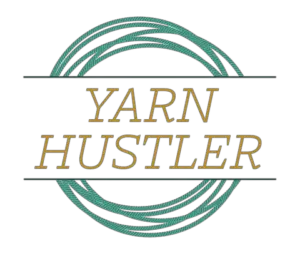Whether you’re a fiber artist or you’re a small farmer looking to increase your herd, this post has it all. Below I’ll give you details about 15 wool breeds that are different than Merino as well as 8 Endangered American heritage breeds that are critically endangered or threatened.
The 15 best wool breeds different than merino are Rambouillet, Bluefaced Leicester, Cormo, Lincoln Longwool, Targhee, Teeswater, Wensleydale, Corriedale, Whitefaced Woodland, Southdown, Border Leicester, Black Welsh Mountain, Manx Loughton, Herdwick, and Polwarth.
The 8 Endangered American Heritage breeds are American Karakul, American Jacob, California Variegated Mutant, Florida Cracker, Gulf Coast Native, Hog Island, Navajo Churro, and Santa Cruz.
We’ll go over the wool characteristics and sheep characteristics for each breed, we have a lot of information to cover so let’s get going.
Table of Contents
15 Wool Sheep Breeds Different Than Merino
If you’re a fiber artist like me, then you want to know what other different breeds of sheep out there are different than Merino. Don’t get me wrong, Merino is great, but there’s so much more to explore!
Most of the information I’ll be using will come from Oklahoma State University’s Breed information or the Livestock Conservancy website.
If you’re looking for some information about alternatives to wool, check out my posts about wool vs alpaca, cashmere, and mohair.
Before you dig into this, let’s talk about staple length and micron count. Staple length is how long the fiber will be after it’s shorn off the sheep. The micron count is the fiber diameter and refers to how soft the fiber will be, the lower the micron count, the softer the wool.
Each breed has unique characteristics that are better suited for certain climates and the wool they produce is best for certain types of yarn or garments. With so much information to cover, we better get started.
1. Rambouillet
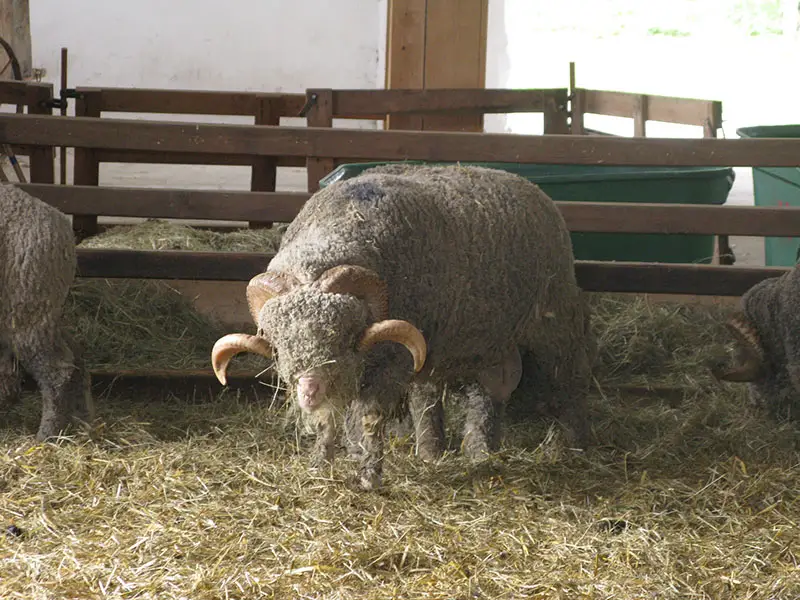
The Rambouillet sheep is the French cousin to the Spanish Merino sheep. Because of that, it is a popular breed alternative to Merino and holds many of the same characteristics as Merino wool.
I’ll be honest, I’m a little biased toward Rambouillet sheep because my brother and I raised them all through high school.
They are kind, gentle sheep that are great for small farmers or herds. However, they are a large breed of sheep with the rams weighing between 250-300 pounds and ewes weighing around 150-200 pounds.
When they are fully grown, these sheep can be the size of a miniature pony. I have accidentally taken a ride on the back of a Rambouillet sheep before when they ran between my legs.
In terms of wool, Rambouillet is one of the fine wool breeds. It has a staple length between 2-4 inches and a micron count between 18.5 and 24.5. For comparison, Merino wool has a staple length of 2-5 inches and a micron count of 11.5 and 22 microns.
This makes Rambouillet a great alternative to Merino and it also has the same benefits as Merino wool garments such as being odor resistant.
In my opinion, Rambouillet is easier to spin than Merino because Merino wool can be slightly slippery and hard to control, especially for a beginner.
2. Bluefaced Leicester
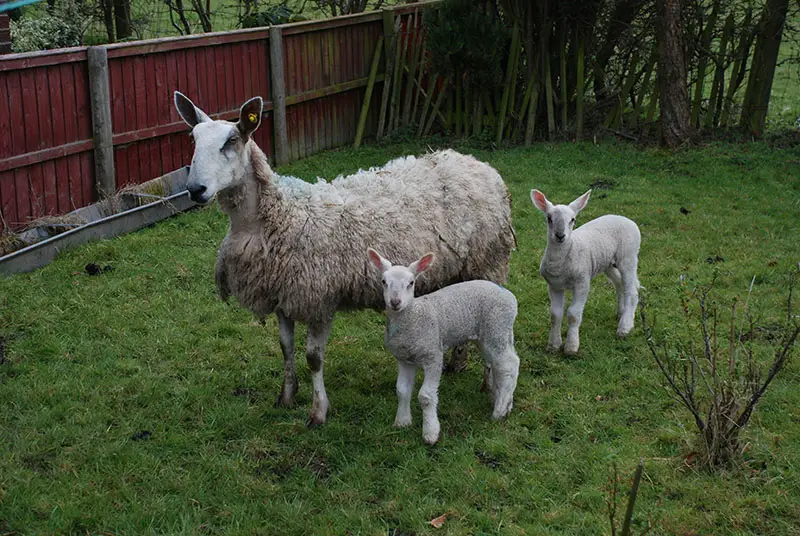
The Bluefaced Leicester sheep (BFL) is a combination of other English Leicester breeds, Wensleydale, and Teeswater so it is considered a longwool breed.
This sheep is characterized by black or grey spots on its face which give it its name. These black spots can also be on its body which gives a multicolored fleece.
They are prolific breeders, the rams can weigh up to 250 pounds and the ewes up to 175 pounds.
Most longwool breeds give a long staple length at the cost of softness, but BFL wool keeps its softness and has a long staple length.
Its staple length is between 3-6 inches with a micron count of 24-28 microns. This wool is easy to spin because of the extra length and thickness.
BFL is a great all-around wool but may not be good for next-to-skin garments if you have sensitive skin. The added length gives durability making it good for outer garments that will get more wear and tear.
3. Cormo
Cormo is another breed that is similar to Merino. Cormo is an Australian breed that was crossed between the Corriedale sheep and the Merino Sheep.
Cormo sheep breed easily and grow quickly. That combined with the high wool quality makes it an excellent choice for wool farmers.
This wool has a staple length of 2 1/2 and 4 inches and a micron count between 17 and 23 microns giving it excellent softness.
This wool is suited for next-to-skin garments and should not be used for garments that will get a lot of wear and tear because it will pill easily.
4. Lincoln Longwool
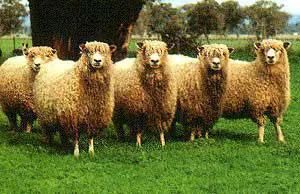
As the name suggests, Lincoln longwool, sometimes just called Lincoln, is a long wool breed that originated in Lincolnshire.
They are considered the largest breed of sheep out there, so I wouldn’t recommend it if you have limited space on your farm. Lincoln rams can weigh between 250-350 pounds and the ewes can weigh between 200 and 250 pounds.
Lincoln wool has a staple length between 8 and 15 inches, that’s longer than my hair. But, what it gives in length it sacrifices in softness, it has a micron count of 33.5 and 41 microns.
Because the wool of Lincoln sheep grows so long, it forms adorable ringlets called locks. These locks are used to create art yarns that showcase the curls. The length also gives added durability because the ends will not pill.
It’s best suited for external garments or garments that will get a lot of wear and tear. It can also be blended with other softer wools. This will add softness to the Lincoln and add durability to the softer wool.
5. Targhee
The Targhee breed was produced by trying to create a sheep with wool like a Merino but that breed easier than Merinos do. The Targhee is a cross between Rambouillet, Lincoln, and Corriedale.
The first Targhees were registered by Montana State University in 1952 making it a relatively young sheep breed. In the beginning, Targhees were bred mostly in Montana, South Dakota, and Wyoming but have now spread throughout the United States.
The wool of a Targhee is between 21 and 25 microns and has a staple length of 3 to 5 inches. This mix of softness and length makes it a great option for most types of yarns and garments.
6. Teeswater
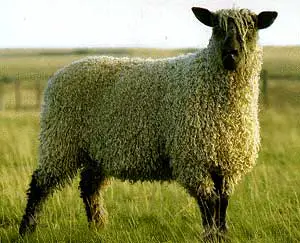
The Teeswater sheep is the original ancestor of nearly all long wool breeds. In the 1900s this breed had a close call with extinction and is still considered a rare wool breed today.
If you’re looking for a way to help out a threatened species, this is a good option. Teeswaters are docile sheep and good breeders. It is a dual-purpose sheep which means it is also good for meat production. These characteristics make it an excellent choice for small farmers.
Teeswater wool has a staple length of 8 to 12 inches and a staple length of 40 to 60 microns which makes it very durable.
Because of this, it’s best suited for outer garments that will need to be sturdy, this wool will be too itchy for next-to-skin garments.
7. Wensleydale
Wensleydale is another long wool breed and its growing popularity is what threatened the Teeswater breed back in the 1900s.
These are slowly maturing sheep with ewes weighing up to 250 pounds and rams weighing up to 300 pounds.
Wensleydale produces good quality wool with a staple length between 7 and 10 inches and a micron count of 32.5 and 34 microns.
This wool is usually mixed with other softer wools to give them added durability.
8. Corriedale

Corriedale is a New Zealand breed which is a cross between Lincoln and Merino sheep. This gives it a good mix of softness and strength.
The Corriedale is a dual-purpose breed which makes it one of the good meat breeds that also has great wool production. It is best suited for temperate climates and higher rainfall areas that produce better pastures.
The wool from Corriedales has a staple length of 3.5 to 6 inches and a micron count of 24.5 to 31.5 microns. These characteristics make a good general-purpose wool for spinners and crafters.
9. Whiteface Woodland

This coarse wool breed originates from the Pennines area of England and is one of the oldest sheep breeds in England.
This breed is a rarer breed with not many people breeding it. It’s also not highly sought after for commercial wool because it’s coarser than most people want.
This wool has a micron count between 28 and 38 microns and a staple length between 5 and 7 inches.
Because of this coarse quality, Whiteface Woodland is primarily used for thick blankets or durable wool rugs.
10. Southdown
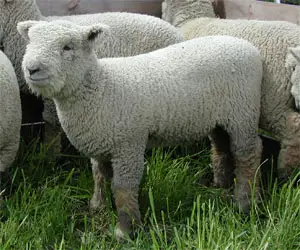
The Southdown breed was brought into the United States in the 1820s. It is a multipurpose breed with fast-maturing sheep, good meat production, average milk production, and good-quality wool.
This makes it a great option for small farms since it’s good at so many different things. The Southdown sheep is good in varied climates but especially suited for wet climates.
The wool produced by the Southdown sheep is considered one of the medium wool breeds with a micron count between 23 and 29 microns and a staple length of 1.5 to 2.5 inches. The wool characteristics make it a good wool multipurpose wool.
11. Border Leicester
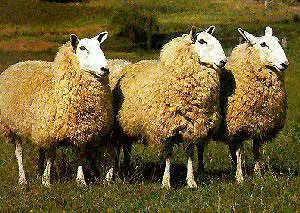
The Border Leicester is closely related to the Bluefaced Leicester with a few different characteristics.
Border Leicester are all white sheep with no spots on their face like the Bluefaced Leicester. The wool of a Border Leicester is usually longer but coarser than that of a Bluefaced sheep.
This breed declined in the 1940s as the wool carpet industry declined. But, it began bouncing back around the 1970s as crafters and handpsinners started having more interest in the Leicester breeds.
The wool has a staple length of five to ten inches and a micron count of 30 to 38.5 microns. This makes it best suited for hardy durable items like outer garments or carpet wool.
12. Black Welsh Mountain
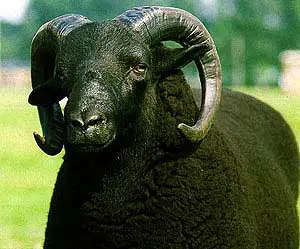
One of the only sheep that produces a completely black or brown fleece. Black Welsh Mountain sheep are considered a specialty sheep and are considered a threatened breed by the Livestock Conservancy.
Although this black wool is desirable for hand spinners, this sheep also produces high-quality meat.
This multipurpose quality combined with its resistance to flies and foot infections makes it an easy to take care of sheep breed.
It has a micron count between 28 and 36 microns and a staple length between 2 to 4 inches which makes it a nice fiber to spin and create with. That combined with its natural black color makes it a fun fiber for crafters.
13. Manx Loughtan
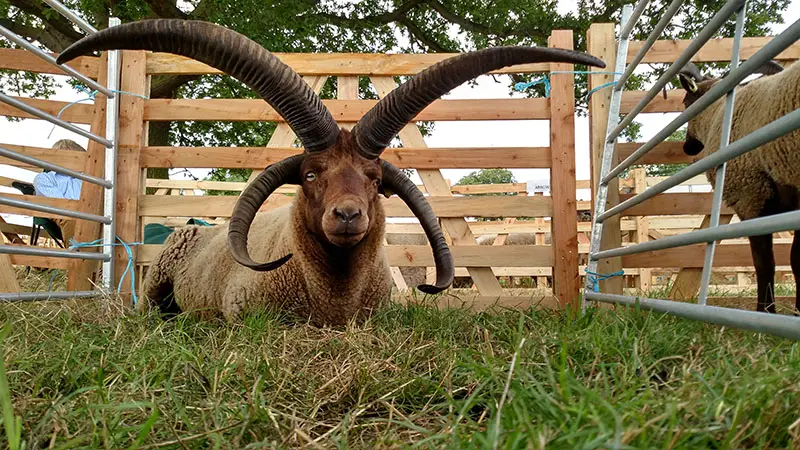
This sheep breed is native to the Isle of Man which is off the coast of England. This naturally brown sheep gives it a unique color to other more common breeds.
The Manx Loughtan is one of the rare breeds and it normally grows four dramatic horns but can sometimes have two or six. As a hand spinner, buying the fleece from rare sheep breed farmers can help protect the breed from endangerment.
The wool produced by the Manx Loughtan has a staple length between 2.5 and 4 inches with a micron count between 27 and 33 microns.
14. Herdwick

The Herdwick breed comes from northwestern England and is a dual-purpose meat and wool sheep. It’s a hardy breed that produces a coarse long wool.
Herdwick wool has a staple length of 6 to 8 inches with a micron count of over 35 microns. This thick long quality makes it best suited for thick wool blankets or wool rugs and carpets.
15. Polwarth
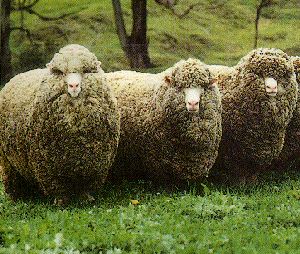
The Polwarth sheep is a cross between the Merino sheep and the Lincoln sheep. It is primarily bred for wool production but it also produces good quality meat.
It is best suited for places with higher rainfall that can produce high-quality pastures like the areas found in Southern Australia.
Polwarth sheep have a high-yielding fleece with a staple length between 4 and 5.5 inches and a micron count between 22 to 25 microns.
This length and softness make it a good general-purpose wool and can be used for just about any wool garment.
8 Endangered American Heritage Breeds
All of the sheep breeds on this list are considered either critically endangered or a threatened species by the Livestock Conservancy.
There are more breeds than just these on the endangered list but there are breeds that are native to and only found in North America.
The Livestock Conservancy also has a program called Shave ‘Em to Save ‘Em. This program gets hand spinners and crafters in touch with farmers who have these heritage breeds so they can buy wool directly from the source.
By buying wool from these farmers, crafters can help these historic sheep breeds stay alive. For more information about this program, here’s a link to their page.
Now, let’s talk about these unique North American breeds.
1. American Karakul
The American Karakul is a combination of English breeds and American breeds. This unique mix can only be found in the United States. It is a mix of Lincoln, Cotswold, American Tunis, and the Navajo Churro.
It is considered a threatened species by the Livestock Conservancy.
This sheep produces a double-coated fleece meaning it has a soft undercoat and a coarser hair-like overcoat. Sheep produce this kind of coat when they live in rugged conditions with different weather patterns.
Karakuls also produce a wide variety of colored fleeces and a single length of fiber can have different colors throughout it.
It has a staple length between 6 to 12 inches and a fiber diameter between 25 and 36 microns.
Yarn made from Karakul is very durable but not very soft, it’s great for creating bags or socks that you want to last for several years.
2. American Jacob
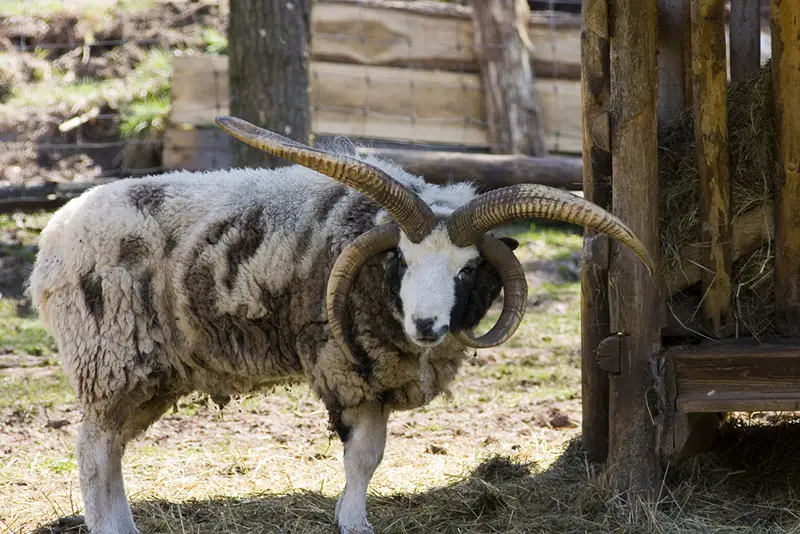
The American Jacob sheep is known for its versatility in both its wool characteristics and wool colors. These sheep are distinct from the English Jacob which are larger and faster growing.
American Jacob sheep can have various colored spots on their fleece ranging from black to brown to light grey.
It is listed as a threatened species by the Livestock Conservancy.
The wool from this sheep has a staple length between 3 and 7 inches and a micron count between 25 to 35 microns. These characteristics make it suitable for many different uses from next-to-skin garments to more durable outer garments.
3. California Variegated Mutant (CVM)

The California Variegated Mutant (CVM for short) is now considered a Romeldale breed but has a few characteristics unique to them. It is a cross between Romney and Rambouillet that was developed in California.
CVM is different from Romeldale because of its unique colorations. This breed and the unique colorations are produced nearly exclusively for fiber artists and crafters.
This low demand makes it a rare sheep breed and it is considered threatened by the Livestock Conservancy.
It has a staple length between 3 to 6 inches and a fiber diameter of between 21 and 25 microns. It’s great for next-to-skin garments and its color variations from white to grey to brown make it very versatile.
4. Florida Cracker
The Florida Cracker is a sheep breed native to the Southeastern United States. This sheep was not bred for any commercial production and instead has adapted to its environment to survive as a wild sheep.
This breed is believed to have evolved from a Spanish sheep that was introduced to the southeastern area of the continent as early as the 1500s.
The Florida Cracker is listed as Critically Endangered by the Livestock Conservancy.
Because of the environmental adaptability, the characteristics and color of this breed vary more than commercial sheep breeds.
The history of this sheep means it has a slight crispiness distinct from commercial wools which can give knitted stitches a distinct look.
This combined with its softness mxakes it a fun wool to work with and explore. It has a staple length between 2.5 and 3 inches and a micron count between 24 and 34 microns.
5. Gulf Coast Native
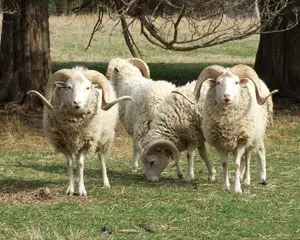
Another North American original breed, the Gulf Coast Native is found in states around the Gulf Coast, primarily Arkansas, Louisiana, Mississippi, Missouri, and Texas.
This sheep is considered semi-feral because it needs little to no human oversight to survive in the wilderness.
This breed has adapted to the harsh environment around the Gulf Coast which means it has a highly variable fleece.
This high variability means that it is difficult to process in a commercial mill making it ideal for hand spinners and small crafters. The lack of demand contributes to the Livestock Conservancy listing it as Critically Endangered.
The variability also makes it great for a wide range of things from hardy durable items like bags to softer next-to-skin garments. It has a staple length between 2.5 and 4 inches and a micron count between 20 and 32 microns.
6. Hog Island
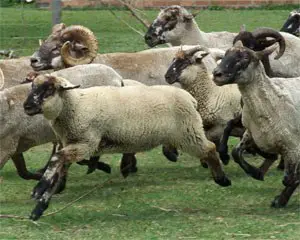
The Hog Island sheep is named after the island off the coast of Virginia where this sheep was found. It lived as a wild sheep without any attention from humans.
DNA testing on this sheep has found a genetic similarity to the Southdown breed which is a down sheep breed meaning it resists felting.
Processing Hog Island wool can be difficult because it tends to have a lot of vegetable matter stuck in the wool. But, working through it can be rewarding, yarn made from this wool produces extremely warm garments.
This difficult processing means it’s undesirable as a commercial wool so it is considered critically endangered by the Livestock Conservancy.
The characteristics of this wool are difficult to determine because it has such variation and is so rare. But, this wool has an estimated staple length of 1.5 to 2.5 inches and an estimated micron count of 22 to 32 microns.
7. Navajo Churro
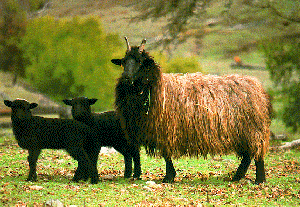
The Navajo Churro is native to the Southwestern United States and has adapted to survive in the arid harsh environment of that area.
This sheep produces a double coat which means it has a long hair-like outer coat and a soft warm inner coat. The ratio between the inner coat and the outer coat will vary depending on the specific environment of the sheep.
When the sheep is in its natural arid environment, it produces very little lanolin which is a natural waterproofing wax produced by sheep. It’s unnecessary to produce lanolin in places without much rainfall, but if the sheep are raised in places with higher humidity it will produce more lanolin.
This rare breed is considered critically endangered by the Livestock Conservancy.
The combination coat makes this wool extremely durable and was historically used for rugs and tapestries but can also be used to create other durable garments.
Navajo Churro has an outer coat staple length between 6 to 12 inches and a micron count of over 35 microns. The undercoat has a staple length between 3 to 5 inches and a micron count between 10 and 35 microns.
8. Santa Cruz

Much like the Hog Island sheep, the Santa Cruz sheep exists only in North America and lived wild on an island off the coast of California until the end of the 20th century.
The Santa Cruz sheep has such a small population that it’s difficult to find high-quality wool. This rare small population means this breed is listed as critically endangered by the Livestock Conservancy.
This wool has incredible crimp which gives it amazing elasticity unique to this breed. The low micron count means it’s suited for next-to-skin garments.
Santa Cruz wool has a short staple length between 2 and 4 inches and a micron count between 18 to 26 microns. These are just estimates since there are very few sheep that produce enough wool to study.
